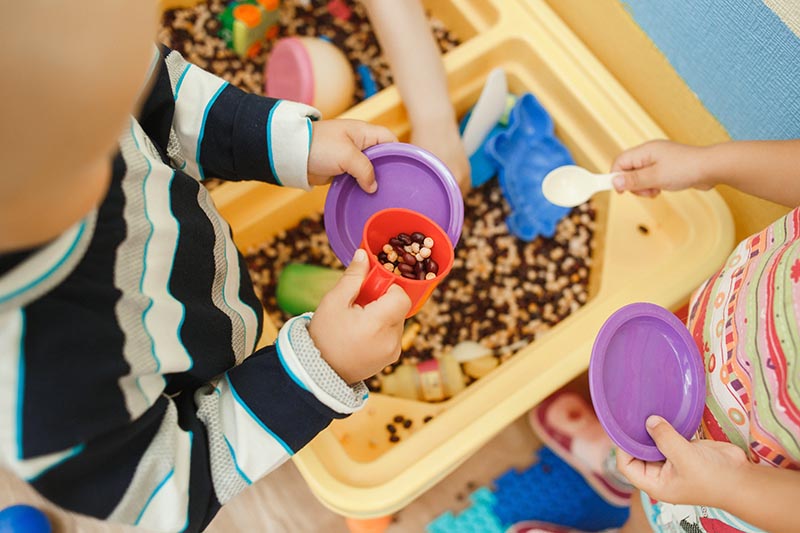Sensory play is a fun and effective way to support your child’s development. It engages their senses—touch, sight, sound, taste, and smell—while fostering creativity, fine motor skills, and cognitive growth. Best of all, it’s easy to set up at home with simple activities and items you likely already have.
Here’s how to get started:
1. Create a Sensory Bin
- What to Do: Fill a large container with materials like rice, pasta, sand, or dried beans. Add small toys, scoops, and containers for your child to explore.
- Why It Works: It encourages tactile exploration and imaginative play.
- Pro Tip: For younger toddlers, place the bin on a high chair tray to keep the mess contained.
2. Incorporate Water Play
- What to Do: Fill a shallow tub with water and provide items like cups, spoons, and floating toys. Add food coloring or a drop of bubble bath for extra fun.
- Why It Works: Splashing, pouring, and scooping strengthen fine motor skills and hand-eye coordination.
- Pro Tip: Use a high chair or a portable playpen to keep the activity safe and mess-free.
3. Introduce Textures
- What to Do: Offer materials with various textures, like fabric scraps, playdough, foam, or even household items like bubble wrap. Let your child explore the different feels.
- Why It Works: This activity builds tactile awareness and curiosity.
- Pro Tip: Keep textured items in a small basket in your child’s play area for easy access.
4. Get Creative with Nature
- What to Do: Collect leaves, flowers, rocks, or sticks from the backyard or park. Let your child explore them with their hands or create simple crafts.
- Why It Works: Nature-based sensory play helps kids connect with the environment while stimulating their senses.
- Pro Tip: Use your stroller to turn this into a fun outdoor adventure while gathering materials.
5. Sound and Music Exploration
- What to Do: Provide instruments like tambourines, shakers, or pots and pans. Encourage your child to create rhythms and experiment with sounds.
- Why It Works: Sound play enhances auditory skills and introduces the basics of music.
- Pro Tip: A lightweight high chair or booster seat can double as a play station for this activity.
6. DIY Sensory Bottles
- What to Do: Fill clear plastic bottles with water, glitter, beads, or small toys. Seal the caps securely and let your child shake, roll, and explore the bottles.
- Why It Works: These bottles provide visual stimulation and are a calming tool for fussy moments.
- Pro Tip: Use them during stroller rides to keep your little one entertained.
7. Smell and Taste Play
- What to Do: Use fragrant items like vanilla, cinnamon, or citrus for smell exploration. For taste, try safe and mild foods like fruit slices or flavored water.
- Why It Works: Engaging the senses of taste and smell enhances sensory development and curiosity.
- Pro Tip: Use a sturdy high chair for these activities to ensure safety.
Why Sensory Play Matters
Sensory play not only supports developmental milestones but also helps children explore and make sense of the world around them. By incorporating simple, engaging activities at home, you’re creating a stimulating and nurturing environment for your child to thrive.
Ready to enhance your sensory play setup? Check out our selection of high chairs, playpens, and more.
